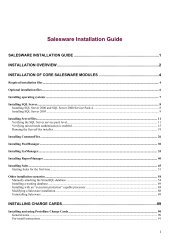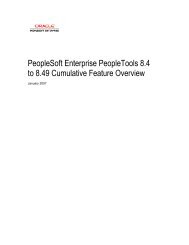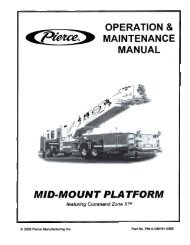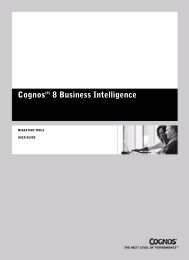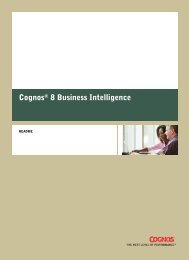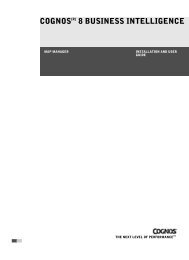COGNOS Business Intelligence Series 7
pes.pdf
pes.pdf
Create successful ePaper yourself
Turn your PDF publications into a flip-book with our unique Google optimized e-Paper software.
Chapter 1: Enterprise Reporting<br />
• Cognos Planning<br />
• Cognos Consolidation<br />
These other OLAP sources require an associated pointer file (.mdc) that is easily created using the<br />
PowerPlay Connect utility. For information about OLAP data sources, see the OLAP Server<br />
Connection Guide.<br />
For information about the most recent database versions supported, see the Cognos Global<br />
Customer Services Web site (http://support.cognos.com).<br />
You can add cubes to a PowerPlay server using PowerPlay Enterprise - Server Administration or<br />
the ppadmtool command-line utility (p. 101).<br />
Reports<br />
Reports are prepared for report consumers using any PowerPlay client application. PowerPlay<br />
users can register a report on the server (publishing) themselves. To publish a report, users must be<br />
connected to a cube on PowerPlay Enterprise Server (a remote cube). Publishing a report creates a<br />
.ppx file that is associated with the cube.<br />
You may add reports using PowerPlay Enterprise - Server Administration or the ppadmtool<br />
command-line utility. However, you must ensure that the associated cube is also on a PowerPlay<br />
server, which should always be the case if the .ppx file was created while the user was connected to<br />
a remote cube.<br />
Location<br />
The data source files for cubes and reports may be located on the same computer as the server,<br />
that is, the query or report processor component, or elsewhere on the LAN.<br />
Performance<br />
Performance is generally faster when the data sources are located on the computer that processes<br />
them.<br />
You can also optimize cube performance in Transformer. For example, you can partition large<br />
cubes to speed up access to more frequently requested categories. For information about creating<br />
and optimizing cubes, see Discovering Transformer.<br />
Consider placing cubes on a computer where PowerPlay Enterprise Server is installed to reduce<br />
network traffic. This also ensures that cubes are read into memory for processing as quickly as<br />
possible.<br />
Windows Privileges<br />
Under Windows, services can log on only to system directories, by default. To allow PowerPlay<br />
Enterprise Server to access remote cubes, for example, if you use a UNC path, you must give<br />
account logon privileges for the remote systems to PowerPlay Enterprise Server.<br />
For information about configuring account logon privileges, see the Windows documentation for<br />
the Services application of the Control Panel to configure Startup properties.<br />
Retain Cubes from Previous Versions<br />
If you upgrade from a previous version of PowerPlay Enterprise Server, you can retain the settings<br />
for the cubes you currently administer.<br />
For instructions about upgrading from a previous version of PowerPlay Enterprise Server, see the<br />
installation guide.<br />
14 Cognos PowerPlay (R)




